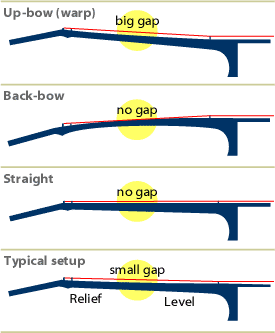Acoustic Guitar Truss Rod Diagram

Its purpose is to help counteract the forces on the neck from the tension of steel strings.
Acoustic guitar truss rod diagram. Future make an adjustment and check your progress with the feeler gauge until you reach the clearance of 007. Before tightening your truss rod it s always a good idea to give it a short counter clockwise turn to loosen it. Here we have an extremely over tightened truss rod if you tried to tighten this rod further you without doubt would risk damaging it. The necessary truss rod adjustment depends on which way the neck bows.
Which way do you turn a truss rod which way you turn a truss rod depends on the desired effect. Whilst the truss rod adjustment itself isn t necessarily going to set the action how you want it it is a necessary first step. If your neck bows outward between the seventh and twelfth frets creating a large gap that makes pressing down the strings difficult tighten the truss rod by turning the nut clockwise as you face the nut straight on. You might need to do an acoustic guitar truss rod adjustment for a couple of reasons.
The other end is anchored to give the adjusting. To do a professional guitar setup or professional bass setup you want the neck to be level flat. It might be because you need to adjust the action of your guitar. The overall process if relatively simple but if you ve never installed a truss rod and fretboard before then it can seem intimidating.
If you look closely you will see that i have raised the saddle in this diagram. Even with this saddle. An adjustable truss rod is a slim steel rod embedded in the neck. One end is threaded for an adjusting nut and is accessible at either the peghead or through the soundhole.














































